Emsam
Generic name: selegiline (transdermal)
Drug classes: Dopaminergic antiparkinsonism agents, Monoamine oxidase inhibitors
Medically reviewed by A Ras MD.
What is Emsam?
Emsam is a prescription medicine used to treat a certain type of depression called Major Depressive Disorder (MDD). Emsam belongs to the class of medicines known as monoamine oxidase inhibitors (MAOI). Emsam is a transdermal system (patch) you apply to your skin.
It is important to talk with your healthcare provider about the risks of treating depression and also the risk of not treating it. You should discuss all treatment choices with your healthcare provider.
Talk to your healthcare provider if you do not think that your condition is getting better with Emsam treatment.
Description
EMSAM® contains selegiline, a MAOI antidepressant. When applied to intact skin, EMSAM is designed to transdermally deliver selegiline over a 24-hour period.
Selegiline base is a colorless to yellow liquid, chemically described as (-)-(N)-Methyl-N-[(1R)-1-methyl-2-phenylethyl]prop-2-yn-1-amine. It has a molecular formula of C13H17N and a molecular weight of 187.30. The structural formula is:
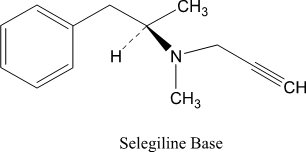
EMSAM transdermal systems are available in three strengths that deliver approximately 6 mg, 9 mg, or 12 mg of selegiline over 24 hours. Each corresponding system has an active surface area of 20 cm2, 30 cm2, or 40 cm2 containing 20, 30, or 40 mg of selegiline, respectively. The composition of the systems per unit area is identical.
EMSAM is a matrix-type transdermal system composed of three layers as illustrated in Figure 1 below. Layer 1 is the Backing Film that provides occlusivity, physical integrity and protects the adhesive/drug layer. Layer 2 is the Adhesive/Drug Layer. Layer 3 consists of side-by-side release liners that are peeled off and discarded by the patient prior to applying EMSAM. The inactive ingredients are acrylic adhesive, ethylene vinyl acetate/polyethylene, polyester, polyurethane, and silicone coated polyester.

Figure 1: Side view of EMSAM system. (Not to scale.)
Mechanism of Action
The mechanism of action of selegiline (the drug substance of EMSAM) as an antidepressant is not fully understood, but is presumed to be linked to potentiation of monoamine neurotransmitter activity in the central nervous system (CNS) resulting from its irreversible inhibition of the enzyme monoamine oxidase (MAO).
What is the most important information I should know about Emsam?
1. Antidepressant medicines may increase suicidal thoughts or actions in some children, teenagers, and young adults within the first few months of treatment.
2. Depression and other serious mental illnesses are the most important causes of suicidal thoughts and actions. Some people may have a particularly high risk of having suicidal thoughts or actions. These include people who have or have a family history of bipolar illness (also called manic-depressive illness) or suicidal thoughts or actions. How can I watch for and try to prevent suicidal thoughts and actions?
- 1. Pay close attention to any changes, especially sudden changes in mood, behavior, thoughts, or feelings. This is very important when an antidepressant medicine is started or when the dose is changed.
- 2. Call the healthcare provider right away to report new or sudden changes in mood, behavior, thoughts, or feelings.
- 3. Keep all follow-up visits with your healthcare provider as scheduled. Call the healthcare provider between visits as needed, especially if you have concerns about symptoms.
Call a healthcare provider right away if you have any of the following symptoms, especially if they are new, worse, or worry you:
- thoughts about suicide or dying
- attempts to commit suicide
- new or worse depression
- new or worse anxiety
- feeling agitated, restless, angry or irritable
- panic attacks
- trouble sleeping
- new or worse irritability
- acting aggressive, being angry or violent
- acting on dangerous impulses
- an extreme increase in activity or talking (mania)
- other unusual changes in behavior or mood
3. Emsam is not for children less than 12 years of age. Emsam may cause a severe increase in blood pressure in children less than 12 years of age.
Who should not use Emsam?
Using Emsam with certain antidepressants and certain pain, cold and cough symptom medicines may cause a potentially life-threatening problem called serotonin syndrome (See “What are the possible side effects of Emsam?”).
Do not use Emsam if you:
- take certain medicines including:
- selective serotonin reuptake inhibitors (SSRIs) such as fluoxetine, sertraline, or paroxetine
- serotonin and norepinephrine reuptake inhibitors (SNRI) such as venlafaxine or duloxetine
- clomipramine or imipramine (tricyclic antidepressants)
- meperidine, tramadol, methadone, pentazocine, propoxyphene (opioid medicines)
- dextromethorphan
- carbamazepine
- are less than 12 years of age
- have a tumor on your adrenal gland called a pheochromocytoma
Ask your healthcare provider or pharmacist if you are not sure if you take these medicines.
What should I tell my healthcare provider before using Emsam?
Before you use Emsam, tell your healthcare provider about all of your medical conditions, including if you:
- have high blood pressure
- have mania or bipolar disorder (manic depression)
- have or had seizures or convulsions
- drink alcohol
- have any other medical conditions
- are pregnant or plan to become pregnant. Emsam may harm your unborn baby.
- are breastfeeding or plan to breastfeed. It is not known if Emsam passes into your breast milk. Do not breastfeed during treatment with Emsam and for 5 days after the final dose. Talk to your healthcare provider about the best way to feed your baby if you use Emsam.
Tell your doctor about all the medicines you take including prescription and over-the-counter medicines, vitamins, and herbal supplements. Emsam and some medicines may interact with each other, may not work as well, or may cause serious side effects when taken together.
Especially tell your healthcare provider if you take:
- other medicines to treat depression (antidepressants) including other MAOI medicines
- decongestant medicines to treat cold or cough symptoms
- over-the-counter diet pills or herbal weight-loss products
- any herbal or dietary supplement that contains tyramine
- medicines called stimulants or uppers (amphetamines)
- buspirone, an anxiety medicine
Some of these medicines need to be stopped for up to 5 weeks before you can start using Emsam and for 2 weeks after you stop using Emsam.
Ask your healthcare provider or pharmacist if you are not sure if you take these medicines.
Know the medicines you take. Keep a list of them to show your healthcare provider or pharmacist when you get a new medicine.
How should I use Emsam?
- Read the Instructions for Use that come with Emsam for information about the right way to use Emsam,
- Use Emsam exactly as your healthcare provider tells you to use it.
- Use only 1 patch at a time.
- Apply your patch right after you open the sealed pouch.
- Change your patch 1 time each day at the same time each day. Choose a time of day that works best for you.
- Your healthcare provider may need to change your dose of Emsam until it is the right dose for you.
- If you use too much Emsam (overdose) you may have the following symptoms:
- drowsiness
- irritable
- severe headache
- your head, neck and spine arch backwards
- fast or irregular pulse
- blood circulation problem
- high fever
- dizziness
- hyperactive
- seeing things that are not there
- seizures
- high blood pressure
- chest pain
- sweating
- fainting
- agitated
- stiff jaw
- coma
- low blood pressure
- trouble breathing
- cool, clammy skin
If you have any of these symptoms of Emsam overdosage, remove your patch right away and call your healthcare provider or go to the nearest hospital emergency room right away. It may take up to 12 hours before you have these symptoms, and they may be worse 24 to 48 hours after you apply your Emsam patch.
What should I avoid while using Emsam?
- Avoid exposing the Emsam application site to external sources of direct heat, such as heating pads or electric blankets, heat lamps, saunas, hot tubs, heated water beds, and prolonged direct sunlight.
- Do not eat foods or drink beverages that contain high amounts of tyramine while using Emsam 9 mg or Emsam 12 mg or for 2 weeks after you stop using Emsam 9 mg or Emsam 12 mg. Continue to avoid tyramine-rich foods or beverages for 2 weeks after a dose reduction to Emsam 6 mg.
- If you start and continue Emsam 6 mg you do not need to make any diet changes.
- The table below lists foods and drinks you should avoid while you use Emsam 9 mg and Emsam 12 mg.
| Type of Food and Drink | Foods and drinks you should avoid that contain Tyramine |
| Meat, Poultry, and Fish |
|
| Vegetables |
|
| Dairy (milk products) |
|
| Drinks |
|
| Other |
|
- All foods you eat must be fresh or properly frozen.
- Avoid foods when you do not know how those foods should be stored.
- Ask your healthcare provider if you are not sure if certain foods and drinks contain tyramine.
- Do not drive, operate heavy machinery or do other dangerous activities until you know how Emsam affects you.
- You should not drink alcohol while using Emsam.
What are the possible side effects of Emsam?
Emsam may cause serious side effects, including:
- See “What is the most important information I should know about Emsam?”
- serotonin syndrome. A potentially life-threatening problem called serotonin syndrome can happen when you use Emsam while you take certain medicines called MAOIs. Symptoms of serotonin syndrome include:
If you suddenly have these symptoms, stop using Emsam immediately by removing the patch and go to the nearest hospital emergency room right away.
- a sudden, severe increase in blood pressure (hypertensive crisis). A hypertensive crisis can happen when you eat certain foods and drink certain beverages while you use Emsam. A hypertensive crisis can lead to stroke and death.
See “What should I avoid while using Emsam?”
A hypertensive crisis can also happen if you use Emsam with certain other medicines. See “Who should not use Emsam?”
Symptoms of a hypertensive crisis include:- sudden, severe headache
- vomiting
- a fast heartbeat (palpitations) or a change in the way your heart beats
- the pupils in your eyes increase in size
- fast or slow heart beat with chest pain
- nausea
- stiff or sore neck
- excessive sweating, sometimes with fever or cold clammy skin
- light bothers your eyes
- bleeding in your brain
If you suddenly have these symptoms, go to the nearest hospital emergency room right away.
- mania or hypomania (manic episodes) in people who have a history of mania. Symptoms of manic episodes include:
- greatly increased energy
- severe problems sleeping
- racing thoughts
- reckless behavior
- unusually grand ideas
- excessive happiness or irritability
- talking more or faster than usual
The most common side effects of Emsam include:
- a skin reaction where the patch is placed. You may see mild redness at the site when a patch is removed. This redness should go away within several hours after removing the patch. If irritation or itching continues, tell your healthcare provider.
- headache
- trouble sleeping (insomnia)
- diarrhea
- dry mouth
- indigestion
- rash
- sore throat
- sinus infection
These are not all the possible side effects of Emsam. Call your doctor for medical advice about side effects. You may report side effects to FDA at 1-800-FDA-1088.
General information about the safe and effective use of Emsam
Medicines are sometimes prescribed for purposes other than those listed in a Medication Guide. Do not use Emsam for a condition for which it was not prescribed. Do not give Emsam to other people, even if they have the same symptoms that you have. It may harm them. You can ask your healthcare provider or pharmacist for information about Emsam that is written for health professionals.
How should I store Emsam?
- Store Emsam at room temperature between 68°F to 77°F (20°C to 25°C).
- Store Emsam in the sealed pouch it comes in until you are ready to use it.
- Keep Emsam and all medicines out of the reach of children.
What are the ingredients in Emsam?
Active Ingredient: selegiline
Inactive Ingredients: acrylic adhesive, ethylene vinyl acetate, polyethylene, polyester, polyurethane, and silicon coated polyester.
For more information, go to www.EMSAM.com or call 1-800-395-3376.
Instructions for use
Step 1. Where to apply Emsam
- Place your Emsam transdermal system (patch) on one of the following areas (sites) on your body. See Figure A.
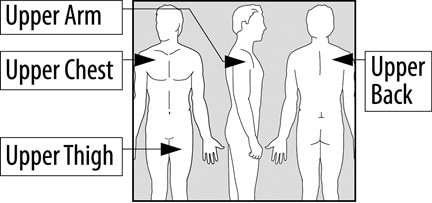
Figure A
- Emsam should be applied to dry, intact skin on the upper torso (below the neck and above the waist), upper thigh or the outer surface of the upper arm. Clothing and movement may make your patch rub off.
- Choose a new site each time you change your patch. Do not use the same site 2 days in a row.
Step 2. Before you apply Emsam
- Make sure the area on your skin where you apply your patch:
- is freshly washed with soap and warm water, then dried with a towel
- does not have any powder, oil or lotion
- does not have any cuts or irritation, including rashes, swelling, redness, or other skin problems
- is not hairy, scarred or calloused
Step 3. How to apply Emsam
- Remove Emsam from its sealed pouch by tearing at the notches (do not use scissors). Pull the pouch open. See Figure B.
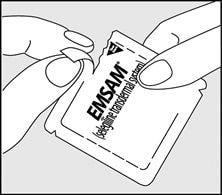
Figure B
- Look at the patch to make sure it is not damaged. The patch should separate easily from the release liner. Throw away the patch if the release liner is hard to remove.
- Do not keep or store your Emsam outside of the sealed pouch. Do not cut your Emsam into smaller pieces.
- The Emsam patch has three layers. See Figures C and D.
Layers:- Release liner: The release liner is the layer that you remove before you put the patch on. See Figure C.
- Adhesive with medicine: The adhesive with medicine is the layer that sticks to your skin. See Figure C.
- Outside backing: The outside backing is the layer you see after you put the patch on your skin. See Figure D.
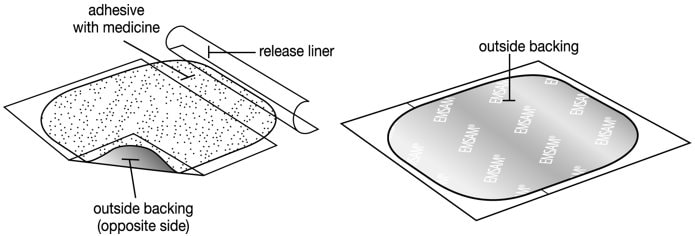
Figure C Figure D
- Apply the patch right away after you remove the patch from its sealed pouch.
- Hold the patch with the release liner facing you.
- Gently peel half of the release liner off the patch and throw it away. See Figure E.
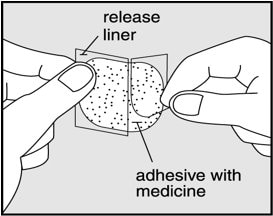
Figure E
- Avoid touching the sticky side of the patch with your fingers. If you accidently touch the sticky side of the patch, wash your hands right away so the medicine does not go into the skin on your hands.
- Using the other half of the release liner as a handle, apply the sticky side of the patch to your selected area. See Figure F.
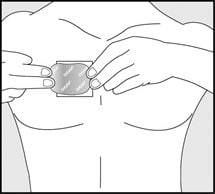
Figure F
- Hold an edge of the remaining half of the release liner and slowly peel it off. See Figure G.
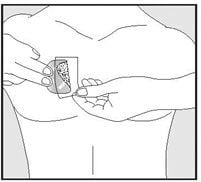
Figure G
- After the release liner is removed, there should not be any adhesive sticking to the liner.
- Using your fingers and palm of your hand, press the entire patch firmly into place against your skin. See Figure H.
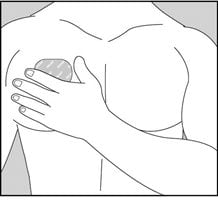
Figure H
- Make sure the patch firmly sticks to your skin.
- Gently rub the edges of your patch with your fingers to make sure the patch sticks to your skin.
- Wash your hands well with soap and water after you apply your patch to remove any medicine. Do not touch your eyes until after you have washed your hands.
- If the patch becomes loose, press it back in place. If your Emsam patch falls off, apply a new Emsam patch to a new site and follow your normal schedule for changing patches.
- If you forget to change your patch after 24 hours, remove the old patch. Put on a new patch in a different area and continue to follow your normal schedule for changing patches.
Step 4. Removing and disposing of your patch
- After 24 hours, remove your patch slowly and carefully to avoid damaging your skin.
- If the patch is too sticky on your skin and you need something to help you remove it:
- Gently wash the area with warm water and mild soap.
- A small amount of oil-based product (petroleum jelly, olive oil, or mineral oil) may be needed to help remove the patch. Gently apply and spread the oil underneath the patch edges.
- Apply an oil-based product or lotion to your skin if any adhesive (glue) remains after you remove your patch. This will gently loosen and remove any adhesive that is left over.
- If you still cannot easily remove the patch, ask your doctor or pharmacist about what to do for this problem.
- Fold the used Emsam patch in half and press it together firmly so that the sticky side sticks to itself.
- Safely throw away the folded patch in a container with a lid right away so that children and pets cannot reach it.
- Safely throw away any unused Emsam patches that are left over from the prescription as soon as they are no longer needed.
- To safely throw away the patches:
- Remove the leftover patches from their protective pouches and remove the release liners.
- Fold the patches in half with the sticky sides together and throw the patches away in a container with a lid.
- Wash your hands with soap and water.
Label
PRINCIPAL DISPLAY PANEL – 6 MG/24 H
- NDC-49502-900-30
- EACH UNIT DOSE PACKAGE IS NOT CHILD RESISTANT
Rx only - EMSAM®
(selegiline transdermal system)
6 mg/24 h - FOR TRANSDERMAL USE ONLY
- Patient: Read enclosed Medication Guide.
- Pharmacist: Dispense with enclosed
Medication Guide. - 30 TRANSDERMAL
SYSTEMS - INSTRUCTIONS FOR APPLICATION
- 1. Select and prepare an appropriate site on the upper chest or back (below the neck and above the waist), the upper thigh, or the outer surface of the upper arm, as directed in the enclosed Medication Guide.
- 2. Bend both sides of the clear peelable liner. Peel off one strip only of the clear liner. Avoid touching the sticky side of the transdermal system.
- 3. Apply sticky side of the transdermal system to the chosen skin site. Remove remaining strip, gently roll remaining part onto skin, and press transdermal system firmly in place with the tips of your fingers.
- For more detailed instructions, read enclosed Medication Guide.

- Dosage: Apply one (1) transdermal system every 24 hours. Read enclosed Medication Guide.
- Each transdermal system has a release rate of 6 mg selegiline per 24 hour period. Wear only one transdermal system at a time.
- Store at 20° to 25°C (68° to 77°F). [See USP Controlled Room Temperature.]
- Dist. by
Mylan Specialty L.P.
Morgantown, WV 26505 U.S.A. - Mfd. for
Somerset Pharmaceuticals, Inc.
Morgantown, WV 26505 U.S.A. - Rx only
- S033:93:30C:R10
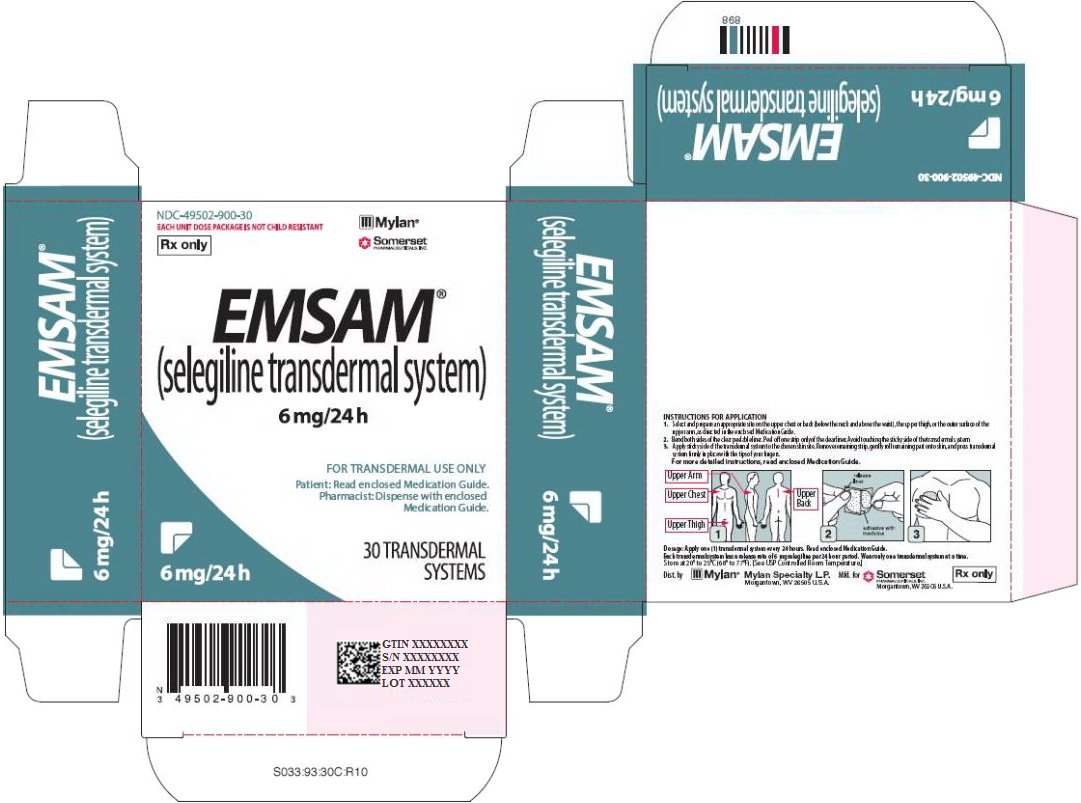
PRINCIPAL DISPLAY PANEL – 9 MG/24 H
- NDC-49502-901-30
- EACH UNIT DOSE PACKAGE IS NOT CHILD RESISTANT
Rx only - EMSAM®
(selegiline transdermal system)
9 mg/24 h - Important: Do not eat certain foods.
Read enclosed Medication Guide. - FOR TRANSDERMAL USE ONLY
- Pharmacist: Dispense with enclosed
Medication Guide. - 30 TRANSDERMAL
SYSTEMS - INSTRUCTIONS FOR APPLICATION
- 1. Select and prepare an appropriate site on the upper chest or back (below the neck and above the waist), the upper thigh, or the outer surface of the upper arm, as directed in the enclosed Medication Guide.
- 2. Bend both sides of the clear peelable liner. Peel off one strip only of the clear liner. Avoid touching the sticky side of the transdermal system.
- 3. Apply sticky side of the transdermal system to the chosen skin site. Remove remaining strip, gently roll remaining part onto skin, and press transdermal system firmly in place with the tips of your fingers.
- For more detailed instructions, read enclosed Medication Guide.

- Dosage: Apply one (1) transdermal system every 24 hours. Read enclosed Medication Guide.
- Each transdermal system has a release rate of 9 mg selegiline per 24 hour period. Wear only one transdermal system at a time.
- Store at 20° to 25°C (68° to 77°F). [See USP Controlled Room Temperature.]
- Dist. by
Mylan Specialty L.P.
Morgantown, WV 26505 U.S.A. - Mfd. for
Somerset Pharmaceuticals, Inc.
Morgantown, WV 26505 U.S.A. - Rx only
- S044:93:30C:R10
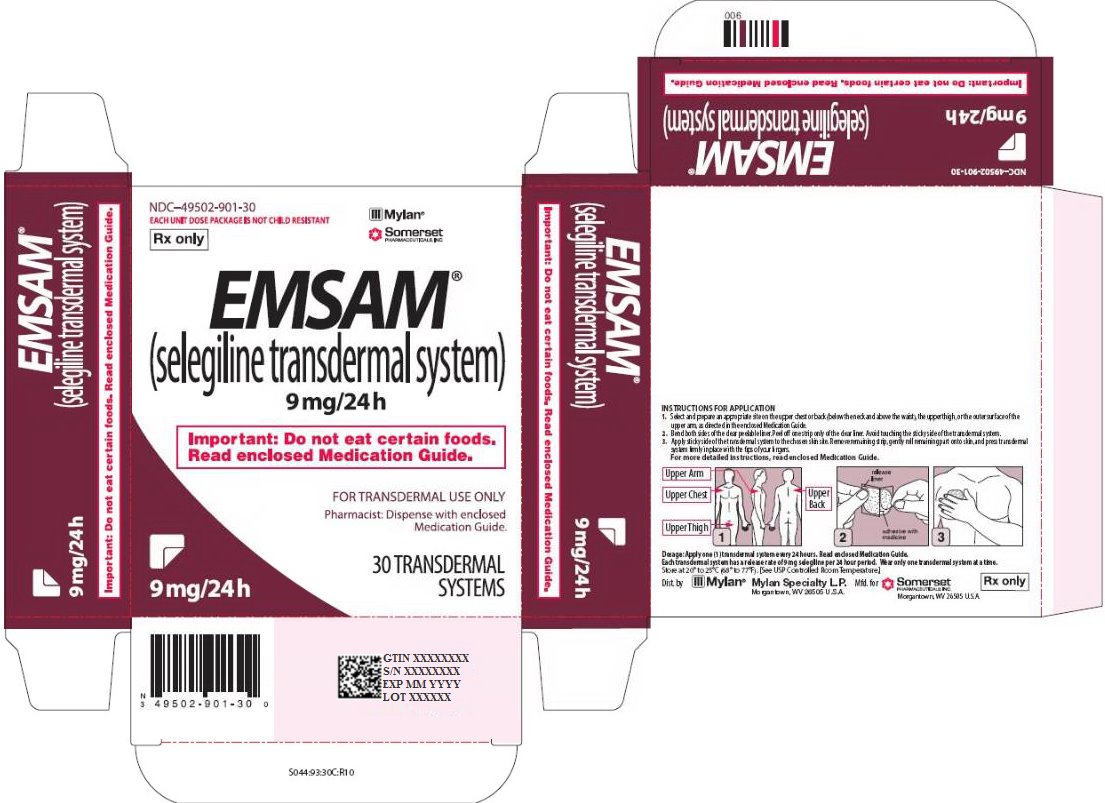
PRINCIPAL DISPLAY PANEL – 12 MG/24 H
- NDC-49502-902-30
- EACH UNIT DOSE PACKAGE IS NOT CHILD RESISTANT
Rx only - EMSAM®
(selegiline transdermal system)
12 mg/24 h - Important: Do not eat certain foods.
Read enclosed Medication Guide. - FOR TRANSDERMAL USE ONLY
- Pharmacist: Dispense with enclosed
Medication Guide. - 30 TRANSDERMAL
SYSTEMS - INSTRUCTIONS FOR APPLICATION
- 1. Select and prepare an appropriate site on the upper chest or back (below the neck and above the waist), the upper thigh, or the outer surface of the upper arm, as directed in the enclosed Medication Guide.
- 2. Bend both sides of the clear peelable liner. Peel off one strip only of the clear liner. Avoid touching the sticky side of the transdermal system.
- 3. Apply sticky side of the transdermal system to the chosen skin site. Remove remaining strip, gently roll remaining part onto skin, and press transdermal system firmly in place with the tips of your fingers.
- For more detailed instructions, read enclosed Medication Guide.

- Dosage: Apply one (1) transdermal system every 24 hours. Read enclosed Medication Guide.
- Each transdermal system has a release rate of 12 mg selegiline per 24 hour period. Wear only one transdermal system at a time.
- Store at 20° to 25°C (68° to 77°F). [See USP Controlled Room Temperature.]
- Dist. by
Mylan Specialty L.P.
Morgantown, WV 26505 U.S.A. - Mfd. for
Somerset Pharmaceuticals, Inc.
Morgantown, WV 26505 U.S.A. - Rx only
- S055:93:30C:R10

SRC: NLM .
